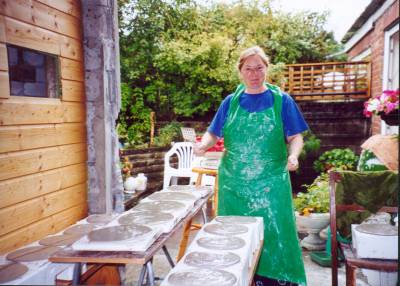
Filling
preparing the clay
The precious substances were split into 111 parts and wedged into the clay that would be rolled into the balls that filled the gTérbum. Clay balls about the size of a large marble were rolled and dried in the oven. The team had to estimate the volume of clay required to make sufficient clay balls to fill a Treasure Vase, so that this amount of clay could be weighed per vase and its precious substances wedged into it. At this point there was a lot of casting slip left over about 20 buckets. Rather than going to the expense and inconvenience of buying several bags of clay, the team decided to experiment with drying the casting slip to a plastic consistency, and seeing if it was possible to roll this into balls. This inspired idea came from Ngala ’ö-Dzin.
It turned out very well and was an excellent way to use up the excess slip. It meant that only two extra bags of clay were needed to supplement it. The only disadvantage was that the slip had to be poured out onto moulds like cow pats to dry enough to weigh and wedge with the precious substances. This was a time-consuming and tricky business to get just right, and also took up a lot of space.
